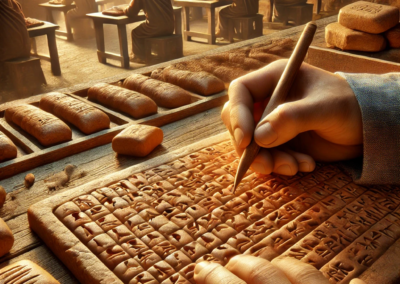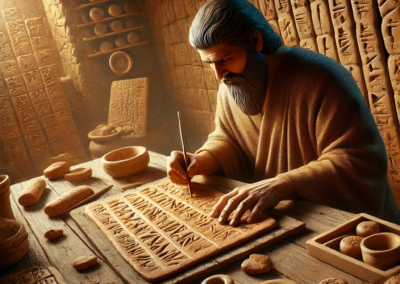How the World’s First Writing System Began
Imagine a world where nothing is written down. No books, no grocery lists, no love letters. Sounds chaotic, right? Well, that was life before the people of ancient Mesopotamia decided, “We should probably keep track of things.” And just like that, writing was born—right in the heart of the Cradle of Civilization.
Cuneiform, the world’s first writing system, didn’t just transform how people communicated; it also preserved stories like the Epic of Gilgamesh. Here’s how it all began, why it’s so fascinating, and how it inspired The Funny Epic of Gilgamesh.
Why Did Writing Begin?
The origins of writing weren’t about storytelling or poetry—they were about keeping receipts. Yes, you read that right. Ancient Mesopotamians developed writing to track their sheep, grain, and beer. When you’re running a city like Uruk, you need to know who owes you two goats and a jar of ale.
Early Tokens and Symbols
Before writing, people used clay tokens to represent goods. For example:
- A small cone-shaped token = one sack of grain.
- A round token = one sheep.
Eventually, they realized it would be easier to draw these symbols on clay tablets instead of carrying tokens around. And voilà, cuneiform was born.
What Is Cuneiform?
Cuneiform means “wedge-shaped,” describing the marks made by pressing a reed stylus into clay. It started with simple pictographs but evolved into abstract symbols, allowing scribes to record more complex ideas.
Think of cuneiform as ancient emojis. For example:
- A drawing of a fish 🐟 might represent “fish.”
- But combined with other symbols, it could mean “fishing,” “trade,” or “dinner.”
In The Funny Epic of Gilgamesh, I couldn’t resist imagining Gilgamesh misinterpreting cuneiform messages—maybe turning a simple note about grain storage into an excuse for an epic feast.
Scribes: The First Writers
Becoming a scribe in Mesopotamia was no joke. It required years of training at a tablet school, or “edubba,” where students practiced writing on clay. Picture young scribes sweating over their tablets while a strict teacher loomed nearby, muttering, “That’s not a proper wedge angle, kid!”
Scribe Superpowers
Scribes were highly respected because they held the key to communication, administration, and storytelling. In many ways, they were the influencers of their time—minus the selfies.
Cuneiform’s Role in Storytelling
While cuneiform began with practical uses, it soon became a medium for creativity. Stories, prayers, and even jokes were etched into clay tablets, preserving them for thousands of years.
The Epic of Gilgamesh
One of the greatest gifts of cuneiform is the preservation of the Epic of Gilgamesh. Without those ancient scribes, we wouldn’t have this legendary tale of friendship, adventure, and immortality. It’s amazing to think that their careful wedge-marks allowed us to connect with a story written over 4,000 years ago.
Fun Cuneiform Facts
- Longest Lasting Medium: Clay tablets don’t burn or decay easily, making cuneiform one of the most durable writing systems. (Take that, paper!)
- Multi-Tasking Symbols: The same symbol could mean different things depending on context, much like modern abbreviations.
- First Libraries: Temples and palaces stored clay tablets, creating some of the world’s first libraries. Imagine Gilgamesh checking out a tablet on “How to Be a Better King.”
Humor in Ancient Writing
Ancient scribes weren’t all serious. Some left behind humorous texts, like complaints from customers or sarcastic proverbs. My favorite is a tablet where a student writes, “I have written it, teacher, but it’s not very good.” (Relatable, right?)
In The Funny Epic of Gilgamesh, I drew inspiration from these snippets of humor, imagining Gilgamesh pestering scribes to write exaggerated tales of his heroism while Enkidu rolls his eyes.
Why This Inspires Me
Cuneiform isn’t just a writing system—it’s a bridge to the past. It reminds us that humans, even thousands of years ago, wanted to record their lives, share their stories, and leave something behind for future generations.
In my retelling of the Epic of Gilgamesh, I wanted to honor that legacy by bringing ancient Mesopotamia’s humor, heart, and history to young readers. Writing has always been about connection, and if a clay tablet can spark a laugh or a lesson thousands of years later, that’s a pretty epic achievement.
Did You Know?
The last known cuneiform tablet was written in 75 AD. That means cuneiform was in use for over 3,000 years!
From Wedges to Words
Every time I write a new chapter, I think about those scribes carving their symbols into clay, wondering if anyone would care about their work centuries later. It’s humbling—and also a reminder to never underestimate the power of a good story (or a well-drawn fish).
If you’re as fascinated by ancient writing as I am, check out The Funny Epic of Gilgamesh: An Ancient Mesopotamia Tale Retold. Who knows, it might inspire you to grab a stylus (or a pen) and create something timeless of your own.
What do you think cuneiform emojis would look like today? Let me know in the comments!


